Merlin Tuttle projects
BAT SCAN PROJECT
The Bat Scan Project officially got under way in August, 2015 when we hired Teresa Nichta to take charge. Thanks to generous assistance from our Bat Fan members and donors, we’re making excellent progress scanning and archiving the top 30 percent of Merlin Tuttle’s collection of approximately 83,000 35 mm Kodachrome slides of bats.
The first step required Merlin’s personal review, prioritizing slides to be scanned and updating for species name changes. Since he began his collection the number of recognized species has grown from 850 to over 1,300, creating a major challenge just to ensure correct identifications! More than 50,000 slides are now sorted according to currently recognized species and are prioritized for scanning.
As of April, 2016, Teresa has cleaned, scanned, key worded and entered more than 15,000 slides into our digital database, and these also have been edited and captioned by Merlin. Approximately 33,000 slides remain to be checked for species changes and prioritized. Then the best 30 percent will be scanned.
Since early March, we have posted approximately 1,200 images of over 270 species from 30 countries on our website. And these are already available for royalty-free downloads by our Bat Fan members, educators and conservationists worldwide through our Bat Photos gallery.
The Merlin Tuttle Bat Photo Collection is irreplaceable. It has served as literally the backbone of scientific, educational and conservation illustration of bats worldwide for nearly 40 years, and has been featured in five National Geographic articles. Nevertheless, film gradually deteriorates, so digital scanning is coming just in time.
Selections of the best newly scanned images will be added to our website on an approximately monthly basis till the project is complete. Merlin also continues to take thousands of new digital images, with a special focus on documenting bat values in places where conservation is most needed. And Teresa is sharing both scans and new images through social media (Instagram, Facebook and Twitter).
We especially thank an anonymous donor, Bettina and Travis Mathis and the Verne and Marion Read family for critical early funding. Donations on behalf of the ongoing project are much needed and deeply appreciated. Our goal is to ensure preservation of Merlin’s priceless legacy for bats, beginning with the Bat Scan Project.
Book Publication
Merlin’s new book, The Secret Lives of Bats: My Adventures with the World’s Most Misunderstood Mammals, was released on October 20, published by Houghton Mifflin Harcourt. Amazon featured it on its top-10 book list in non-fiction, and it received uniformly outstanding reviews, including in The Wall Street Journal, The New Yorker, The Huffington Post, National Geographic Book Talk and Nature. Sharing highlights from a lifetime of adventure and discovery, Merlin takes readers to the frontiers of research and discovery, replacing fear of the unknown with a profound appreciation for these long neglected but essential animals. More than 50 media interviews have reached tens of millions of people worldwide with his message about bats.
COMING PROJECTS
Help for Improving Echo Meter Touch Technology
January 1, 2016 we will provide developers of Echo Meter Touch technology with portraits of all 44 United States bat species for incorporation into their bat detector programing. Their new detector can reliably identify most U.S. species on the wing by analyzing their unique ecolocation calls. Bat calls will be both seen and heard, and a friendly portrait of the identified species will appear, providing an invaluable new tool, both for bat identification and public education. A portion of sales revenue will be contributed to conserving bats through Merlin Tuttle’s Bat Conservation.
RECENT PROJECTS
Ambassadorial Travel for Bats
Wherever he goes Merlin is a captivating ambassador for bats, normally making a lasting difference in each country visited. He provides media appearances, public lectures, training sessions and much needed conservation advice in addition to photographs essential to public education.
TAIWAN – 2016

June 9 to 25, 2016 Merlin and Paula traveled to Taiwan to promote bat conservation. They taught bat photography and conservation techniques while taking 1,836 new photographs of bats, including rare Formosan golden bats (Myotis formosus flavus) rearing young in their foliage roosts, Lesser Asian yellow bats (Scotophilus kuhlii)rearing young in bat houses and Formosan lesser horseshoe bats (Rhinolophus monoceros) and a newly discovered species of Vesper bat (Kerivoula sp.) capturing one of Taiwan’s most costly crop pests, the Oriental leafworm moth (Spodoptera litura). This is one of the most important agricultural pests of Asia, Austral Asia and the Pacific Islands. Our photos of bats capturing these moths in flight are the first of their kind and should prove especially useful in convincing farmers of the need to conserve bats. Merlin also provided lectures to enthusiastic audiences at Taiwan’s National Museum of Natural Science and its Endemic Species Research Institute, as well as at theFormosan Golden Bat’s Home (a museum and Cheng Zheng Elementary School dedicated to promoting bat conservation). Finally, we documented that, contary to frequent warnings in the U.S. that bats should never be permitted near school children for fear of disease, in the 10 years since attracting bats to more than 100 bat houses at this school, not one of some 500 children has been harmed despite frequent close encounters with bats.
TRINIDAD – 2016
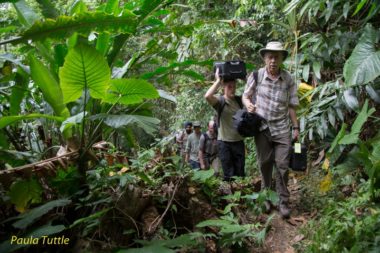
March 16 to April 2, 2015 we worked with two volunteer teams organized by Trinibats, an organization devoted to conserving Trinidadian bats. This island hosts one of the world’s most diverse bat faunas, but until recently bats had been neglected in conservation planning, viewed only as vermin. As the teams worked to document important roosts and habitats needing protection, we helped with field training and photographically documented the bats and their values, as well as the team’s activities, donating photos in support of the organization’s conservation efforts. View the photos here!
FLORIDA – 2015
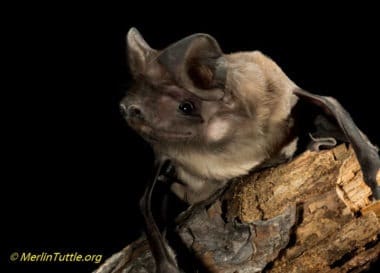
December 13 to 18, 2015 we photographed Florida bonneted bats (Eumops floridanus), North America’s rarest, most endangered bats, so rare they were once thought to be extinct. This is the final U.S. species in Merlin’s North American collection of bat photos for conservation education. We assisted state and federal wildlife officials in documenting the species, as well as their critical research on the bats’ needs. Photos of this beautiful bat and from the trip are available in the photo gallery!
CAMBODIA – 2015
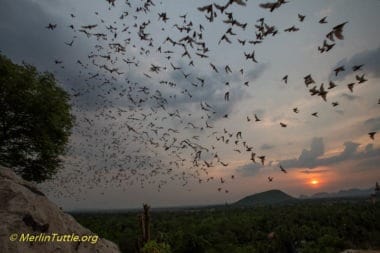
March 19 to April 8, Merlin and Paula traveled to Cambodia. Merlin presented an exceptionally popular, hour-long plenary speech at the 2015 annual meeting of the Asia-Pacific Associates of Tropical Biology and Conservation (ATBC), emphasizing the importance of documenting how humans benefit from conserving bats. The meeting was attended by representatives from 22 countries who met in Phnom Penh, Cambodia. He also co-chaired a bat research symposium and taught a workshop on conservation and management of cave-dwelling bats. Merlin and Paula (assisted by a much valued volunteer, Jeff Acopian) arrived two weeks early for a trip to assess and consult on local conservation priorities and photograph Cambodian bats for the country’s first book on bats. The book is a non-profit work to promote bat conservation. More than 2,100 new bat photos were taken, especially documenting the value of cave protection and artificial roost construction that is a lucrative source of income in several Cambodian communities. The best of these images, combined with approximately 50 of Merlin’s already existing photos of Asian bats known to occur in Cambodia, were donated for use in that country’s conservation efforts. This trip was made possible through generous donations from Daniel and Heidi Hargreaves, Dudley and Mari Houghton and Scott and Hella McVay. View the photos here!
THAILAND – 2015
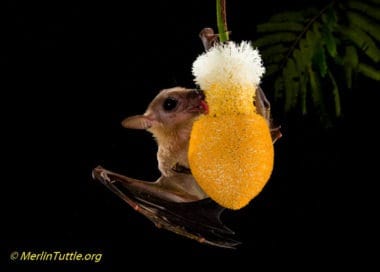
From Cambodia, Merlin and Paula and Jeff Acopian flew directly to Thailand where they worked April 9 to 28. They discovered the apparent cause of recent decline in the huge free-tailed bat population of Khao Chong Pran Cave. Vegetation had encroached on the cave entrance, restricting flight and causing needless mortality. This was easily remedied by strategic tree trimming. Still in Thailand, they visited two Buddhist temple courtyards where relatively tame, protected Lyle’s flying foxes (Pteropus lyei) could be photographed unusually close up. The resulting cute photos of mothers with their pups will be used in support of efforts to gain protection for the species in Cambodia. The remainder of the Thai trip was spent collaborating with Dr. Sara Bumrungsri and his graduate students in bat biology at the Prince of Songkla University in Hat Yai, helping develop educational materials to gain protection for rapidly declining bats essential to pollination of lucrative durian crops. Bats were photographed pollinating a variety of important plants, including durian and mangroves. Nearly 3,000 photos were taken, the best of which were donated for conservation use in Thailand and Cambodia. See Merlin’s photos from Thailand here!
BORNEO – 2014
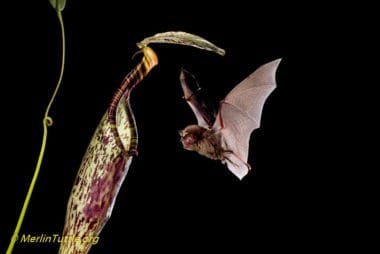
While helping document Caroline and Michael Schoner’s Ph.D. thesis research on woolly bats living in pitcher plants (August 9 to 30) Merlin and Paula took nearly 2,500 photos of this special bat-plant relationship and provided photos for use in professional seminars and public lectures. These photos subsequently reached millions of people with positive messages through stories on popular internet sites, scientific journals and other publications. Additionally, Merlin provided an hour-long lecture on the importance and conservation needs of bats at the University of Brunei Darussalam for the Brunei Nature Society, the country’s leading conservation group, and donated a collection of 51 photos illustrating bat diversity and values.
BULGARIA – 2014
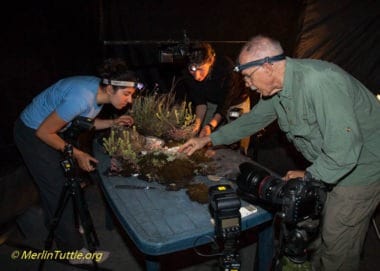
On June 14, Merlin spoke at the British Counsel Education Center in Sophia. His talk, The Amazing World of Bats, was covered by varied news media, including more than 10 minutes on national television. He also appeared in a widely covered press conference, and trained two bat biologist graduate students:Daniela Schmieder and Antoniya Hubancheva. Antoniya received our first student scholarship award, covering special training in Africa. Merlin and Paula and their graduate student assistants also photographed seven genera and 14 species of bats (portraits), including great shots of several species catching prey and roosting. Bulgarian conservationists now have these outstanding images for use in public education. View photoshere!
SOUTH AFRICA – 2014
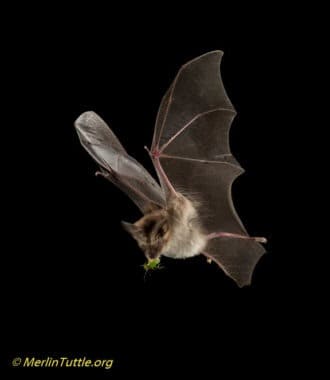
Merlin and Paula spent March 27 to April 29 assisting with bat conservation efforts in South Africa. Merlin spoke to students and professors at the University of Pretoria and to the public at Ridgeway College in the town of Louis Trichart in Limpopo Province. Most importantly, Merlin was able to donate outstanding new photos of 10 genera and 16 species of South African bats, including action shots of slit-faced bats capturing green stink bugs, the most costly pest of macadamia nut orchards. After Merlin spoke to the South Africa Macadamia Growers Association, they funded two Ph.D. thesis projects, supervised by local bat biologist Dr. Peter Taylor, to study how to attract more bats to orchards. View the photo galleryhere!
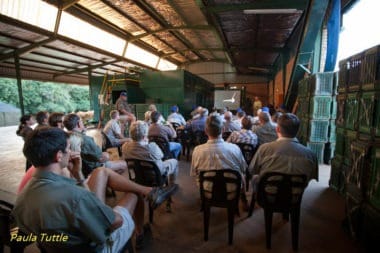
TENNESSEE—2014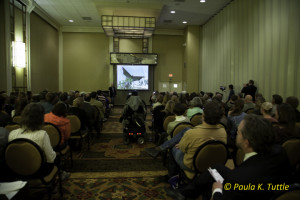

On March 21, Merlin provided the keynote address,The Amazing World of Bats, for the All Taxa Biodiversity Index Conference annual meeting, hosted by Discover Life in America in Gatlinburg, Tennessee. On the following evening he was honored by a special award from the Mayor of Knoxville and gave a public lecture on the importance of bats as pollinators.








COMMENTS